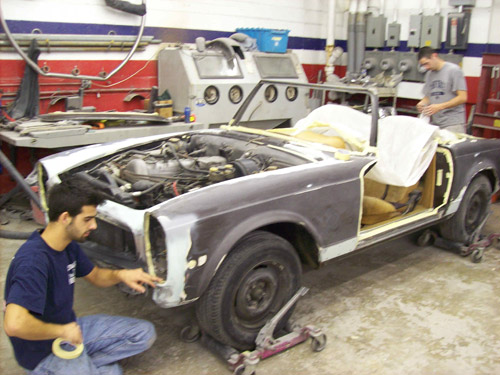With the classic car market booming in Britain, many owners are looking to keep hold of their pride and joy for the foreseeable future. Once a car owner has decided their classic is a keeper, attentions quickly turn to restoration, with a view to returning the car to its former glory.
Without a doubt, the bodywork of a classic car is the most expensive part of a restoration project, and before you undertake a big refurbishment of your own car’s shell, think carefully about the outcome you’re looking to achieve:
Decide How You’ll Use the Vehicle in the Future
Before you start to obsess over paint finishes and styles, have a careful think about what the car is used for. Trying to keep a daily driven classic car in show condition is a soul destroying undertaking, and an expensive restoration isn’t often worth the hassle for the average low cost runaround. Likewise, a show car needs a carefully thought out plan and a very extensive budget to bring it to concours condition.
In addition, you’ll almost certainly need to plan ahead for the required infrastructure: You’ll need a heated garage, and probably a trailer as well. Is that really a route you want to go down?
Start Planning a Budget
Get a pen and paper, get a pot of coffee brewing, and spend an afternoon pouring over parts catalogues and bodywork specialist’s websites. Old cars, much like old houses, can be absolute money pits if you enter into the restoration with zero knowledge or budget limits.
You’ll need to be a little cynical and somewhat pessimistic as well: Be prepared to walk away from a bad car, and even think about selling your existing classic if the cost of restoration is going to be too great. Being a stubborn martyr won’t help you here.
Lift the Car off of the Ground
Take your car to a professional (or several) and have them help you look over the vehicle with a torch and a hydraulic lift. This is much better than wriggling around under the car in a dark garage, and a professional will instantly be able to tell if the bodywork is too far gone to bother with a restoration.
Consider a Complete Re-Shell
A good option for the sentimental owner that insists on restoring a treasured (yet fundamentally wrecked) car is a complete re-body of the vehicle. It may seem extravagant, but when you add up the labour costs of welding, filling, and fabrication, it’s often cheaper to buy a reproduction shell if available.
Choose a Professional Body Shop
There’s a world of difference between a professional body shop and an enthusiastic friend with a spray gun and a welder. www.bodyshopsolutionsltd.com, who supply repair equipment to the industry, agree completely: “Modern body shops are high tech places, with clean, temperature controlled spray booths and advanced paint drying facilities. It’s a world away from a DIY garage, and the results will reflect that.”
Keep it Maintained
Finally, make sure you keep the paintwork in perfect order all year round. Although classic car restoration is an expensive process, it will last for years to come with proper maintenance and care. You’ll often end up with a vehicle that has a better finish than when it left the factory!
By Harry Price
Harry Price is a freelance writer and personal trainer. He retired from interior design to entrepreneurship.
